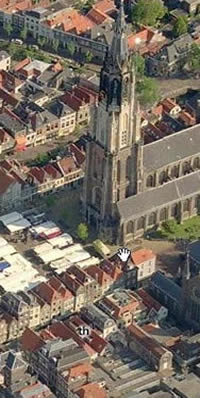Much of the information below was drawn from Kees Kaldenbach's excellent Vermeer website at:
http://www.xs4all.nl/~kalden/dart/d-a-vermeer1.htm
Towards the end of the fifteenthc entury, Vermeer's grandfather, a tailor named Jan, lived with his wife and three children in a house called "Nassau," abutting the Beestenmarkt, a large market square where cattle were sold once a week.
In those days, common people had no last names. Last names were not necessary in Vermeer's time. Jan was known accordingly as "the son of Reynier" (in Dutch, Reynyerszoon, abbreviated Reyersz)."John Michael Montias, Vermeer and His Milieu: A Web of Social History (Princeton, NJ: Princeton University Press, 1989), 42.
"The Beestenmarkt, which today measures sixty by fifty meters, had been in part the location of a former monastery of the Minderbroeders (Minor Friars), belonging to the order of Saint Franciscus. In 1499 the Minor Friars got permission to settle in Delft. They built a monastery with a comparatively large chapel. The building comprised about one-third of the present place and was situated southeast of the Burgwal. In the course of the Reformation the monastery was demolished in 1595 and the place was used for the weekly cattle market, hence its Dutch name 'Beestenmarkt'. But the street name Broerhuisstraat (in former times Grote Broerhuissteg), leaving from one of the corners of Beestenmarkt, still refers to this former monastery."Archaeologie Delft

The animals kept in temporary pens, although at times they would escape. The alleyways surrounding the market were cordoned off during market days to keep those that escaped withing catching distance. Most of the people living around the Beestenmarkt were illiterate.
Especially in the summer, today Beestenmarkt is an important entertainment hub, and as of 2018, the square is surrounded by eleven catering businesses. There are twenty-four plane trees around sixty years old on the square, providing shade in sunny weather. From 2001 to 2014, the square was used annually (except for 2003) for an ice rink.In the center of the square stands The Bull, ceramic artwork by artist Rob Brandt.
The Beestenmarkt played a significant role in the life of the parents of Johannes Vermeer. Reynier lived in Nassau from his birth in 1591 until the death of his father Jan in 1597. Neeltge Goris married in the same year the tailor and musician Claes Corstiaensz, a professional musician, and moved with her three children (Jan, Anthony and Maertge, uncle and aunt of Vermeer) to his house De Drie Hamers (The Three Hammers) (present Beestenmarkt 26). That means that Reynier lived in this house, together with the family of his stepfather, from 1597 until c. 1611, when he went for his apprenticeship in Amsterdam.

corner Broerhuisstraat.
The Hotel De Koophandel
comprises the numbers
26 to 32. The ground floor of
No. 26 is leased to a pub.

Neeltge Goris lived on Voldersgracht no.3 in the house In de Bruynvisch. She was active as uijtdraegster or second-hand-goods dealer, liquidating estates of the deceased. Since paintings were often a part of these estates, Neeltge's dealing in works of art may have kindled the interest of her son Reynier in this commodity. This active woman also sold bedding and promoted lotteries. Her third husband was a ship's carpenter. Women from the lower classes were forced to remarry quickly since they had little or no social protection to speak of.

Reynier, Vermeer's father, went to Amsterdam to learn the trade of a silk-linen weaver (caffawerker) and married Digna Baltens from Antwerp. The couple lived in "De Drie Hamers (the Three Hammers) where their daughter Geertruy was born in 1620. Reynier used the name Vermeer for the first time in 1640. Last names were not necessary in Vermeer's time. We do not know why Reynier chose Vermeer as his name but his brother was already using it at the time.

The public Vermeer information stand on Beestenmarkt indicating the birthplace of Reynier Jansz. Vos, no. 14, is erroneous. The house numbers 14 and 26 were interchanged.

(the narrow facade to the right)'
The larger building to the left is the "Vleeshal" (Meat market).
photo by Pieter Haringsma
 One side of the Beestenmarkt in the winter.
One side of the Beestenmarkt in the winter. (photo by Pieter Haringsma)

MICROSOFT'S Search Maps